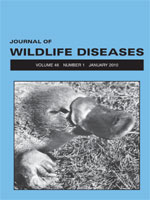To determine whether Bartonella species may perpetuate in sites where ticks are absent, we analyzed blood and spleen samples from small mammals trapped near Cantwell, Alaska during September 1999. Blood smears from seven of 48 Myodes (Clethrionomys) rutilus suggested a Bartonella species infection; five of the seven yielded cultures consistent with Bartonella species; PCR of rrs, gltA, and rpoB genes confirmed Bartonella infection in four of these culture samples. Phylogenetic analysis of rrs, gltA, and rpoB genes demonstrated that the sequences clustered with the Bartonella vinsonii clade. Based on PCR, two additional blood samples and four of 22 spleen samples also contained DNA of this Bartonella species for an overall prevalence of 14% (10/70) among the 70 M. rutilus sampled in this study. We conclude that Bartonella species may commonly infect M. rutilus in a site where ticks are absent.
How to translate text using browser tools
1 January 2010
BARTONELLA SP. INFECTION OF VOLES TRAPPED FROM AN INTERIOR ALASKAN SITE WHERE TICKS ARE ABSENT
Kotaro Matsumoto,
Joseph A. Cook,
Heidi K. Goethert,
Sam R. Telford
ACCESS THE FULL ARTICLE

Journal of Wildlife Diseases
Vol. 46 • No. 1
January 2010
Vol. 46 • No. 1
January 2010
Alaska
Bartonella
Myodes (Clethrionomys) rutilus
ticks




